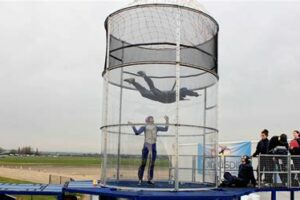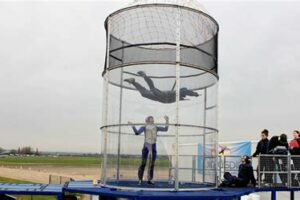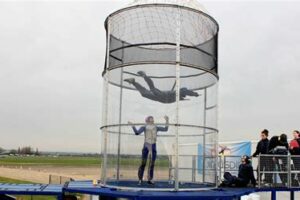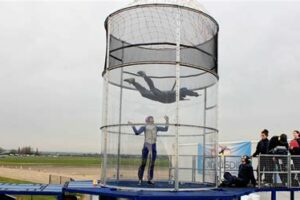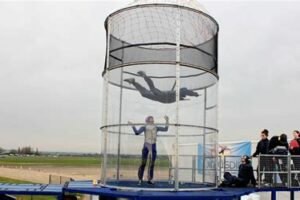Table of Contents
Discover the exhilarating world of indoor skydiving and uncover how it works. This thrilling adventure allows you to experience the sensation of freefall in a controlled environment. From wind tunnels to specialized gear, learn about the mechanics and techniques behind this gravity-defying activity. Prepare to defy gravity and soar like a bird in the safety of an indoor skydiving facility.
Indoor skydiving has become an exhilarating and popular activity that allows people to experience the thrill of freefalling without having to jump out of a plane. But have you ever wondered how it actually works? Well, let me guide you through the fascinating mechanics behind this gravity-defying adventure. First and foremost, indoor skydiving involves a vertical wind tunnel, which generates a powerful updraft of air that can reach speeds of up to 120 miles per hour. This incredible force is what keeps you suspended in mid-air, defying the laws of gravity. So, let’s dive deeper into the step-by-step instructions on how to enjoy this unique experience of indoor skydiving.
Introduction
Indoor skydiving is an exhilarating activity that allows individuals to experience the sensation of freefalling in a controlled environment. Unlike traditional skydiving, which requires jumping out of an airplane, indoor skydiving takes place inside a vertical wind tunnel. This article will provide instructions on how indoor skydiving works, giving you a glimpse into the thrilling world of simulated flight.
The Vertical Wind Tunnel
The key component of indoor skydiving is the vertical wind tunnel. This tunnel consists of a large, powerful fan at the bottom that generates a strong upward flow of air. The wind speed within the tunnel can be adjusted to simulate different levels of freefall. The walls of the tunnel are made of transparent material, allowing spectators to watch the participants as they soar through the air.
Gearing Up
Before entering the wind tunnel, participants must gear up with the necessary equipment. This typically includes a jumpsuit, helmet, goggles, and earplugs. The jumpsuit aids in creating a stable body position and reduces wind resistance, while the helmet, goggles, and earplugs protect the individual from any potential discomfort caused by the strong airflow.
Body Positioning
Proper body positioning is crucial for a successful indoor skydiving experience. Instructors teach participants how to achieve a neutral body position, which involves arching the back, extending the arms and legs slightly, and maintaining a stable posture. This position allows individuals to maintain stability and control while flying in the wind tunnel.
Entering the Wind Tunnel
Once geared up and familiar with the proper body position, participants enter the wind tunnel through a designated entrance area. They step onto a netted floor that provides stability and prevents them from being lifted off the ground before the airflow is activated. The instructor provides guidance and support as the participant prepares for takeoff.
The Sensation of Freefall
As the wind speed is increased, participants will begin to experience the remarkable sensation of freefall. The powerful airflow lifts them off the netted floor, allowing them to float effortlessly in the tunnel. The feeling is akin to skydiving from thousands of feet above ground, with the added advantage of being able to communicate and receive real-time instructions from the instructor.
Control and Maneuverability
Indoor skydiving not only provides the sensation of freefall but also allows participants to have control and maneuverability in the wind tunnel. By adjusting body position and making subtle movements, individuals can change their direction, rotate, and even perform basic skydiving maneuvers such as turns and flips. Skilled flyers can showcase impressive aerial acrobatics within the confines of the wind tunnel.
Interaction with the Instructor
Throughout the indoor skydiving experience, participants have the advantage of interacting with a highly trained instructor. The instructor remains inside the wind tunnel, guiding and providing feedback to help improve body positioning and stability. They use hand signals and verbal cues to communicate with the flyer, ensuring a safe and enjoyable flight.
The Landing
As the session comes to an end, participants prepare for landing. The wind speed gradually decreases, allowing the individual to descend gently towards the netted floor. The instructor guides them to a stable landing position, ensuring a safe touchdown. Once on the ground, participants can reflect on their exhilarating indoor skydiving experience.
Conclusion
Indoor skydiving offers an incredible adventure for individuals seeking the thrill of freefall without the need to jump out of an airplane. By understanding the inner workings of a vertical wind tunnel and following instructions provided by knowledgeable instructors, anyone can experience the sensation of flying in a controlled and safe environment. So, gear up, practice your body positioning, and get ready to soar through the air like never before!
Safety Procedures and Equipment
When participating in indoor skydiving, your safety is of utmost importance. To ensure your well-being, it is crucial to follow the provided safety instructions. The facility will provide you with the necessary safety gear, including a jumpsuit, helmet, goggles, and earplugs. These items are designed to protect you during the flight. Additionally, familiarize yourself with the emergency procedures in case of any unforeseen circumstances. Being prepared and adhering to safety protocols will help create a safe and enjoyable experience.
Wind Tunnel Basics
The heart of indoor skydiving lies in the wind tunnel, a vertical airflow chamber that simulates the freefall experience of traditional skydiving. Equipped with powerful fans, the wind tunnel generates vertical wind speeds of up to 120 miles per hour. This creates an environment that mimics the sensation of weightlessness, allowing you to experience the thrill of flying without actually jumping from an airplane. As you enter the wind tunnel, the force of the air will elevate you, providing a unique and exciting adventure.
Body Positioning and Stability
To maintain stability and control during your indoor skydiving session, it is essential to adopt the correct body positioning. Arch your back slightly and keep your legs straight while in the wind tunnel. This posture helps maintain stability and control as the wind rushes past you. Spread your arms out and use them as wings to control your balance and direction. Remember to relax and keep your body loose, as tension can hinder stability. By mastering these techniques, you can maximize your stability and enjoy the sensation of flight to the fullest.
Instructor Guidance and Communication
Throughout your indoor skydiving experience, trust and listen to your instructor. They are there to guide you and ensure your safety. Your instructor will communicate with you through hand signals during the flight. These signals may indicate adjustments to your posture or the initiation of special moves. It is important to pay attention and follow their lead to make the most out of your indoor skydiving adventure. By relying on your instructor’s expertise, you can fully immerse yourself in this thrilling activity.
Duration of Flight
Each indoor skydiving flight typically lasts for about one to two minutes. This duration provides enough time for you to experience the wonders of simulated skydiving. However, it is important to note that indoor skydiving can be physically demanding. Longer sessions may lead to fatigue, so it is advisable to take breaks as needed. Many facilities offer multiple flights within a session, allowing you to refine your skills and enjoy extended periods of simulated flight. This ensures that you have ample time to fully enjoy the experience.
Suitable for All Ages and Fitness Levels
Indoor skydiving is an accessible activity suitable for people of all ages. Whether you are a young child or an adult, you can participate in this exhilarating adventure. However, individuals with certain medical conditions or physical limitations may be restricted from participating. It is recommended to consult with the facility beforehand to ensure your eligibility. The intensity of the wind tunnel can be adjusted to accommodate different fitness levels, making it suitable for beginners and experienced skydivers alike. This flexibility ensures that everyone can enjoy the thrill of indoor skydiving.
Post-flight Debrief and Souvenirs
After your indoor skydiving flight, take the opportunity to discuss your experience with your instructor during the debriefing session. This allows you to improve your skills and receive valuable feedback. To cherish your incredible adventure, consider purchasing photos or videos of your flight from the facility. These souvenirs serve as a lasting memory of your indoor skydiving experience. Additionally, you may have the option to take home a flight certificate or other merchandise to commemorate your thrilling adventure.
Benefits and Thrills
Indoor skydiving offers the thrill of traditional skydiving without the fear of jumping from an airplane. This makes it an ideal activity for adrenaline junkies seeking an exhilarating experience. Beyond the thrill, indoor skydiving also offers various benefits. By participating in this activity, you can improve your body control, balance, and spatial awareness. The sensation of defying gravity and maneuvering in the wind tunnel provides a unique opportunity for personal growth. Furthermore, indoor skydiving serves as an excellent introduction to outdoor skydiving, allowing you to familiarize yourself with the sensation and techniques before taking on the real thing. It is a truly unforgettable adventure that combines excitement and personal development.
Indoor Skydiving: How It Works
Indoor skydiving is an exciting and safe activity that allows individuals to experience the sensation of freefalling in a controlled environment. Here’s a step-by-step guide on how indoor skydiving works:
- Arrival: Upon arrival at the indoor skydiving facility, participants will be greeted by trained instructors who will guide them through the entire process.
- Registration and Safety Briefing: Before starting the activity, participants will need to sign a waiver and go through a safety briefing. The safety briefing will cover the basic rules and guidelines to ensure a safe and enjoyable experience.
- Gearing Up: Once the safety briefing is complete, participants will be provided with the necessary gear, including a jumpsuit, helmet, goggles, and earplugs. It is essential to wear the gear properly to ensure maximum safety during the flight.
- Training: Before entering the flight chamber, participants will receive a short training session from the instructors. They will learn the correct body positions and hand signals to use while flying. The instructors will also explain how to enter and exit the flight chamber safely.
- Entering the Flight Chamber: After the training session, participants will enter the flight chamber one at a time. The flight chamber is a vertical wind tunnel that generates a powerful upward airflow, simulating the feeling of freefalling.
- Flight Experience: Once inside the flight chamber, participants will be guided by the instructor who will help them maintain a stable and controlled body position. The instructor will provide feedback and assistance, ensuring a safe and enjoyable flight experience.
- Duration: The duration of each flight varies depending on the package chosen. Typically, a first-time flyer will have multiple flights, each lasting around 1-2 minutes. More experienced flyers can opt for longer flight durations.
- Debriefing: After the flight session is complete, participants will have a debriefing with the instructor. They will provide feedback on the participant’s performance and offer tips for improvement.
- Photos and Videos: Many indoor skydiving facilities offer the option to purchase photos and videos of the flight experience. This allows participants to capture their thrilling moments and share them with friends and family.
- Celebration: Finally, participants can celebrate their indoor skydiving adventure by sharing their experience with others and relishing in the sense of accomplishment.
Indoor skydiving provides an exhilarating experience for people of all ages and fitness levels. It allows individuals to defy gravity and experience the thrill of skydiving without the need for an airplane or parachute. So, if you’re seeking a unique and adrenaline-pumping activity, give indoor skydiving a try!
Thank you for visiting our blog and taking the time to learn about indoor skydiving and how it works. We hope that this article has provided you with valuable insights into this thrilling and unique adventure sport. Whether you are a seasoned skydiver or someone looking for a new and exciting experience, indoor skydiving offers a safe and exhilarating way to feel the rush of freefall.
Indoor skydiving, also known as vertical wind tunnel flying, is a simulation of the freefall experience without the need for an airplane or parachute. It involves entering a vertical wind tunnel, which generates a powerful upwards airflow that allows you to float effortlessly in mid-air. This technology was initially developed for training purposes in the military and has now become a popular recreational activity.
So, how does indoor skydiving work? The wind tunnel consists of a large glass chamber with a powerful vertical fan at the bottom. As you enter the tunnel, the fan creates a column of air that moves upwards at high speeds. This column of air supports your body weight, allowing you to experience the sensation of freefall. Skilled instructors are present throughout the experience to guide you and ensure your safety.
Indoor skydiving is suitable for people of all ages and fitness levels. It doesn’t require any previous skydiving experience, making it accessible to beginners who want to try something new. The wind speeds in the tunnel can be adjusted to accommodate different skill levels, from gentle breezes for beginners to hurricane-force winds for experienced flyers who want a more challenging experience.
In conclusion, indoor skydiving is a thrilling and safe way to experience the sensation of freefall. It offers an opportunity for everyone to defy gravity and enjoy the adrenaline rush of skydiving without the need for an airplane or parachute. So why not give it a try? Visit your nearest indoor skydiving facility and embark on this unforgettable adventure!
Thank you once again for visiting our blog, and we hope to see you soon in the vertical wind tunnel!
.
People also ask about indoor skydiving and how it works. Here are some commonly asked questions:
1. How does indoor skydiving work?
Indoor skydiving, also known as vertical wind tunnels, simulates the experience of freefalling through the air. It involves a vertical chamber with powerful fans at the top that create a controlled updraft of air. Participants wear special jumpsuits and helmets to ensure safety.
2. What is the purpose of indoor skydiving?
The purpose of indoor skydiving is to provide a safe and controlled environment for people to experience the sensation of skydiving without the need for an airplane or parachute. It allows individuals to practice bodyflight skills, improve coordination, and have an exhilarating experience.
3. Is indoor skydiving safe?
Yes, indoor skydiving is generally considered safe when proper safety protocols and instructions are followed. The wind tunnel facilities have trained instructors who guide participants and ensure their safety throughout the experience. Safety equipment such as helmets and jumpsuits are provided to minimize any potential risks.
4. Can anyone try indoor skydiving?
Most indoor skydiving facilities have age and weight restrictions for participants. Generally, children as young as three years old can try indoor skydiving, while there may be weight limits for safety reasons. It is always recommended to check with the specific facility for their age and weight requirements.
5. How long does an indoor skydiving session last?
The duration of an indoor skydiving session can vary depending on the package or experience chosen. Typically, a single flight lasts for about one to two minutes, which is equivalent to the duration of a skydive from an airplane. Some packages may include multiple flights or additional training sessions.
6. Do you need any prior experience to try indoor skydiving?
No prior experience is required to try indoor skydiving. The facilities provide training and instructions before the flight, including body positioning and hand signals. Instructors are present throughout the session to guide participants and ensure a safe and enjoyable experience for everyone.
Indoor skydiving offers a thrilling opportunity for individuals to experience the sensation of freefalling in a controlled and safe environment. Whether you are looking for an adrenaline rush, want to improve bodyflight skills, or simply have a unique adventure, indoor skydiving can be a fantastic choice.

